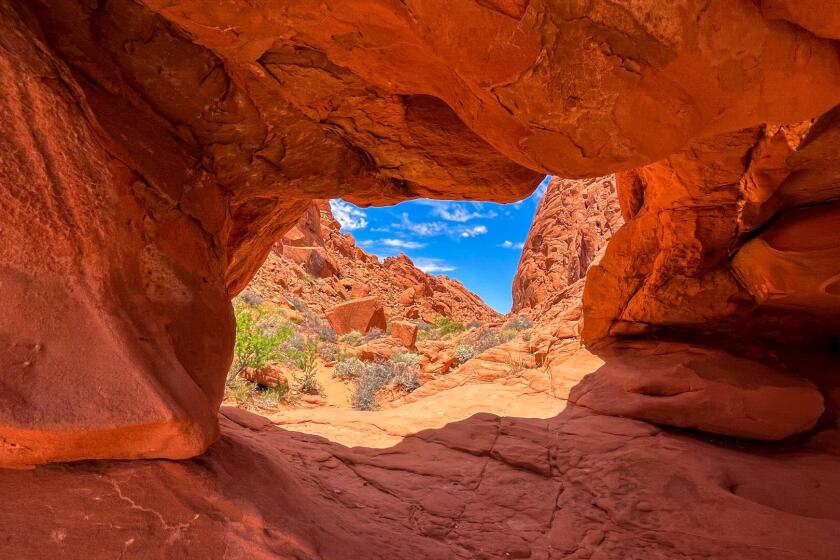Yosemite Tries to Deal With Its Popularity
Never have so many people been turned away from the gates of this national treasure. This weekend--the sixth weekend in a row--hundreds of visitors arrived in their cars and vans only to be told to come back later in the day when the crowds in Yosemite Valley had thinned.
It did not matter if they had crossed an ocean to get here or driven eight hours or once broke bread with President Clinton. The park rangers manning the entrances had heard it all before. Mighty and meek alike, they were sent back down the mountain.
“It’s probably the hardest job we do,” said park ranger Kristine Hutchinson. “Some people take it pretty well. Some people don’t.”
When the gates did open again four hours later, there were two Yosemite Valleys that greeted these visitors. The supercharged waterfalls, the green meadows, the granite wonder. And the bumper-to-bumper traffic, the wily games to land a parking spot, the big tour buses belching din and diesel.
To be sure, the crowded conditions and unprecedented restrictions are partly the result of this winter’s record snowpack, which has closed access to Yosemite’s high country and concentrated too many visitors in the narrow valley.
But even when Tioga Pass opens in two or three weeks, the National Park Service expects to continue the practice of turning away visitors who arrive during the busiest hours without hotel or campground reservations.
Simply put, there are too many people coming here and not enough roads and parking lots to accommodate them. More than 4 million people made their way to Yosemite last year, nearly doubling since 1981.
Long ago, the Park Service acknowledged that the automobile was killing the “Yosemite experience.” But a solution has been more elusive.
Last week, in yet another plan to ease the gridlock, the Park Service released a three-year study that included a controversial proposal to build an 1,800-space parking lot a mile east of Bridalveil Fall.
The consultant who authored the study favored the $10.9-million parking area as the cheapest and friendliest to the public. Visitors would drive to the valley floor, park their vehicles in the 22-acre lot and board shuttles taking them from one popular spot to the next. It would reduce congestion by as much as 77%.
But environmental groups say another parking lot on the valley floor ignores the Park Service’s own goals to reduce the urban feel of Yosemite. They favor an approach in which visitors would park their cars in nearby mountain communities, board a bus to Yosemite’s entrance and then take a shuttle to the valley floor.
“My main criticism of the report is that it admits defeat at the front end,” said Jay Watson of the Wilderness Society. “It says that people aren’t going to change so we have to accommodate their expectation that they can drive their cars right into the park.
“We happen to believe that people would be willing to change their habits for one of the icons of this country.”
This is not a new debate. In 1907, a few years after the first car made its way into Yosemite Valley along Old Wawona Road, the federal cavalry officer overseeing the park banned all automobile traffic.
The ban stayed in effect for six years, until Secretary of the Interior Franklin K. Lane announced a new vision: “I want to make our parks as accessible as possible to the great mass of people.”
He could not have foreseen the stampede to this glacier-carved canyon--2.5 million in 1981, 3.4 million in 1991, 4.1 million last year.
The landmark general management plan for Yosemite committed the Park Service in 1980 to reducing the crowding and eliminating all cars from the valley. “Increasing automobile traffic is the single greatest threat to the enjoyment of the natural and scenic qualities of Yosemite,” the report stated.
Since then, at least six plans for removing some or all cars have been announced, prodded and forgotten. Tour buses, first allowed in the park in 1977, have become nearly as omnipresent as Half Dome. So have the signs telling people when and where not to park. Views of the raging Merced River are cut off on both sides by high volumes of traffic, parking lots and buildings.
Like so many other visitors this summer, Tony and Beverly Dunn were drawn by the waterfalls gorged with the heavy snowmelt. Natives of England who now live in San Jose, the Dunns no longer have the patience for weekends here. They arrived early last week and left Friday, before the hordes descended on the valley. Still, they had to contend with long lines and bumper-to-bumper traffic.
After two previous visits, they said, they had mastered the strategies of finding a parking spot--a mixture of stealth and pure audacity.
“We wait at one end of the lot looking for people walking with their keys exposed,” Beverly Dunn said. “When that doesn’t work, we’ve been known to drive on the wrong side of the road to get a spot.
“People look at us nasty and we tell them, ‘Sorry, we’re British. We didn’t know better.’ ”
On Saturday morning, when the crowds did arrive and the valley approached gridlock, the Park Service decided to restrict access at the three gates and allow in only tour buses, the handicapped and those with overnight accommodations. Caltrans was alerted and electronic signs along Highways 41, 120 and 140 were activated, informing people of the restrictions.
Plenty of people either did not see or chose to ignore the signs. Park ranger Hutchinson says she opens her heart and listens to everyone’s plea. She tries to explain the situation--that Tioga Pass is still closed and thus more people congregate in the valley, that a park worker was killed by an avalanche June 13 as he tried to clear Tioga Road.
Most people understand but some persist--they’re on their honeymoon, they’ve shared the same dinner table with Bill Clinton, they’ve come all the way from Germany or France. She has heard all the excuses, a few of which she has even believed.
“We hand them flyers informing them of places to go and things to see in the nearby communities,” she said. “And we tell them to try back later in the day. A lot of them return and we wave them through.”
The new superintendent, B.J. Griffin, the first woman to oversee Yosemite, has promised a long-term solution to the crowding. She has stressed to concerned environmentalists that last week’s study was just a study. No decision has been made.
But whether the Park Service decides on a parking lot near Bridalveil Fall or one of the more environmentally sound but expensive options, one thing is certain: The restrictions will continue and eventually lead to a system where people will have to call the park in advance for a reservation to visit.
“Calling to make a day-use reservation isn’t asking a lot,” said Wilderness Society’s Watson. “Heck, you’ve got to do that to go out to dinner.”
Sign up for The Wild
We’ll help you find the best places to hike, bike and run, as well as the perfect silent spots for meditation and yoga.
You may occasionally receive promotional content from the Los Angeles Times.



